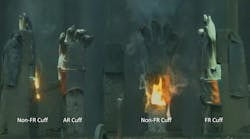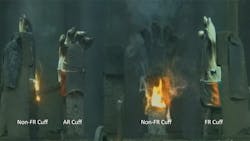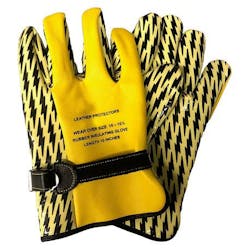ArcWear recently announced the publication of ASTM F3258-21, Standard Specification for Protectors for Rubber Insulating Gloves Meeting Specific Performance Requirements, on its blog. An accredited lab, ArcWear performs ASTM F3258 Arc Rated Protector Glove testing to the following hazards: arc flash, cut, puncture resistance, and more.
ASTM F3258 goes beyond the ASTM F696-06 (2019), Standard Specification for Leather Protectors for Rubber Insulating Gloves and Mittens, to include testing and a labeled arc rating in cal/cm². Gloves can be dual certified to ASTM F3258 and ASTM F696 if they are primarily leather. ASTM F696 only specifies leather type, tanning type, and thickness minimums, but this will coexist with ASTM F3258 in the industry. Many end-users have wanted thinner, lighter-weight, more dexterous, and more cut-resistant gloves. This new standard now can meet that need. Manufacturers may choose the attributes they would like to make claims, perform testing, and label classifications accordingly.
Several years in the making, the new standard now allows many non-leather materials to be used in protector gloves for rubber insulating gloves. For several decades, the only standard (ASTM F696) option for protector gloves was “grain cowhide, buffed grain cowhide, grain deerskin, grain pigskin, grain horsehide, or grain goatskin” of a certain thickness. No specifications for protector gloves existed for puncture resistance, cut resistance, seam requirements, or cuff flame resistance. Fortunately, leather has performed well for flame and heavier leather can receive a cut resistance of as much as A2, but leather still had issues with grip when wet, dexterity, chemical resistance, and in some work applications (such as pharmaceutical and food service). The fact that leather could not be laundered posed a huge problem in cross-contamination and decontamination in these environments. Until now, there was no performance-based standard available to address these issues. This has now changed with ASTM F3258.
The ASTM International Task Group responsible for developing the standard tested many of the glove leathers on the market, established minimum performance criteria (based on the weakest of leather allowed by the ASTM F696 standard), and provided initial guidance for specifiers of protector gloves for the characteristics necessary in protector gloves. The following tests are required to be performed:
- Puncture resistance [EN 388]
- Cut resistance [ASTM F2992]
- Arc rating (AR) [ASTM F2675]
- Afterflame time limit in an arc test [ASTM F2675]
- Arc ignition withstand [ASTM F2675]
- Thread requirements (Either ASTM F696 or ASTM D7138 Method B – Thread Melt)
The following optional tests are specified in ANSI/ISEA 105 and NFPA 1971 if required by the specifying party:
- Abrasion resistance [ANSI/ISEA 105] using either ASTM D3389 for coated materials or ASTM D3884 for textile materials
- Classification of dexterity [ANSI/ISEA 105]
- Torque test [NFPA 1971- Sec. 8.68]
- Hypodermic needle puncture [ASTM F2878]
- ASTM F1001 chemical resistance testing [Using either ASTM F903 Penetration or ASTM F739 Permeation]
Gloves meeting this standard would be acceptable under the OSHA standards and the NFPA 70E standard, since these both require, in many cases “protector gloves” that have an “arc rating.” Both OSHA and NFPA standards mention ASTM F696, but neither requires only that standard for protector gloves.
The best glove for your work situation may already be available. There are now more than three manufacturers certifying gloves to this new standard, and more are in the process of dual certifying their leather protectors using ASTM F696 and ASTM F3258 to provide more information about the performance of their gloves to end-users.
The standards group is still discussing the puncture requirement, currently requiring a minimum of one in the ANSI 105 scale of both the palm and back of the hand. This will limit the dexterity of the initial gloves coming to market because it requires the back to be leather or to be thinly coated to meet the back of the hand puncture requirement. The majority supported testing for a puncture on the palm and back and having a minimum only on the palm to allow more form-fitting protectors, but ASTM regulations require 90% agreement to move a standard’s dissent to ballot — and the 90% was not reached initially on this subject.
With the introduction of this standard, the ASTM F18 committee will continue to drive innovation by allowing non-leather materials like para-aramids, flame-resistant threads, and other innovations to enter the marketplace with tested performance characteristics. In the process of testing, one glaring weakness was observed in ASTM F696 gloves: There was no requirement for cuff materials to be flame resistant. While there are no known incidents of ignition of glove cuffs in field use, many burned, melted, and dripped in arc flash exposures during testing. Any glove dual certified to both ASTM F696 and ASTM F3258, or certified to ASTM F696, arc-rated by ASTM F2675, and passing the ignition withstand test in F2675, will no longer have a cuff material that can ignite, melt, or continue to burn.
Watch for lighter-weight, more cut-resistant arc-rated protector gloves soon. The standard ASTM F3258-21 is available at ASTM.org. Click to view the ArcWear ASTM F3258 Glove Testing Page.
Hoagland is a semi-retired, independent consultant and an expert in arc flash, flame and thermal testing, and electrical safety. He has participated in more than 200 incident investigations for arc flash, flash fire, and electrical shock events since 1994. Hoagland has been part of committees in NFPA, ASTM, IEC, ANSI, CSA, ISEA, and worked with various national committees on electrical safety. Founder of the ArcWear testing laboratory and e-Hazard electrical safety training and engineering company, he can be reached at [email protected].





